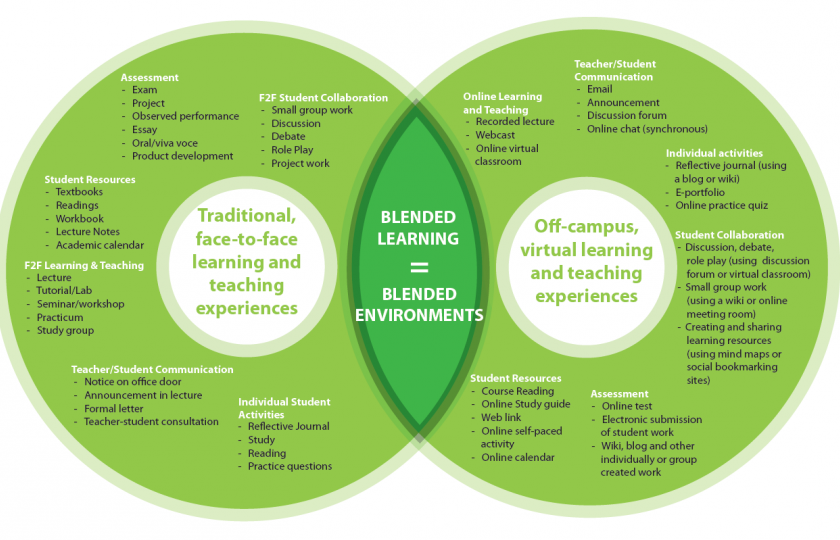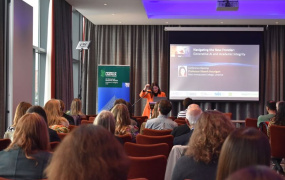Blended Learning Design
What is Blended Learning?
Both face-to-face and online mediums offer different advantages to the learners. Blended learning recognises that a learning environment should exploit the most appropriate medium to deliver a quality learning experience. It allows you to choose which learning should take place face to face and which should be delivered using technology. It is up to each lecturer to determine how much learning should take place online. You do not have to create a learning environment that offers all content through technology. Most lecturers start by developing online content such as PowerPoint presentations and offering them on a Virtual Learning Environment (Moodle). They then progress to using Moodle to communicate with students, submitting assignments and giving assignment feedback, this is often followed by using technology to offer diverse learning experiences such as collaborative, social and reflective learning. Please see this link to view the blended learning continuum.
Why use Blended Learning?
Blended learning offers opportunities for students and staff to participate in learning in ways, which might be difficult to do solely in a face-to-face classroom environment. It can allow you to improve student learning without spending more time teaching. This can be accomplished by encouraging students to learn both independently and from their peers as well as you, the academic. It can allow students to continue their learning outside of the classroom by providing opportunities for them to reflect and engage without time constraints.
Rather than being about technology, blended learning is about supporting students in achieving their learning outcomes using diverse learning experiences. Figure 1 below illustrates different opportunities for blended learning.
The diagram below illustrates different opportunities for blended learning.

Approaches to designing blended learning
There are a variety of approaches to designing blended learning. One approach looks at blending at three different impact levels (see this link for more information)
- 'Low-impact blend: adding extra activities to an existing course
- Medium-impact blend: replacing activities in an existing course
- High-impact blend: building the blended course from scratch.' (Alamary, 2017)
Regardless of the impact you use it is important to follow some key steps:
Firstly, it is important to consider a number of different aspects of your module. You will need to identify who are your students (year, class size, profile what support might they need); what are your learning outcomes; what is your content inventory (resources you are using); what is your teaching approach; what works well in your course (face to face); what might work better; will moving some of the learning activities online improve the student learning outcomes?
If you feel a blended approach may suit your module, you then need to identify and design which aspects may be delivered using technology. Activities should be mapped to your learning outcomes and clear instructions should be given to the learner about how these activities should be completed. Consideration should be given to the student hours required and this should be made transparent to the student. The ABC Learning Design curriculum development workshop is a very effective method to assist this process.
It is also important to consider how these activities will be implemented, for example in what sequence, what support will be required and how often should the support be given to the learner?
The lecturer should also consider how the student will be graded. Regardless, the student should be given feedback, consideration needs to be given about how the student should receive and use the feedback.
Implement the design and provide support. The design should be monitored to determine if students are engaging and how. You will need to determine the impact this will have on their learning outcomes. This information can be gathered in a number of ways, viewing student activity on the VLE (Moodle), doing a content analysis of their contributions to wikis, discussion forums, observing how students interact online and in face to face activities. Consideration should also be given to the student’s learning experience and their feedback through student evaluations of teaching.
Please view the UCD guide to blended and online learning design and Griffith University’s guide to Getting started with Blended Learning for more information on designing blended learning environments.
Further reading
- Lau, A., Blackey, H. and Jones, N., 2006, May. Embedding blended learning in a higher education institution. In Fifth Annual International Conference on the Scholarship of Teaching and Learning (SoTL) 2005, Goodenough College, 12th _13th May 2005, London, UK (p. 196).
- Griffith University (2010): Getting started with Blended Learning
- Alammary, A., Sheard, J. and Carbone, A., 2014. Blended learning in higher education: Three different design approaches. Australasian Journal of Educational Technology, 30(4). Accessed on 10 August 2018.
- About ABC Learning Design. Accessed on 15 December 2020.







